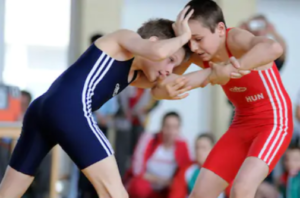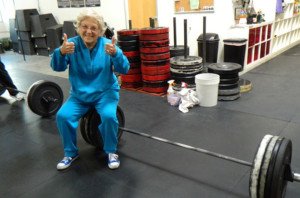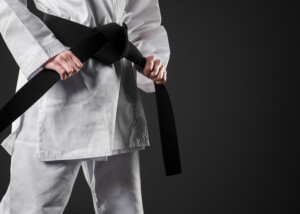Why Parents Should Never Ground Kids from Playing Sports

Take away the sports and you take away all the benefits that athletics provide for kids. Instead, ground them from mindless games.
“There is a difference between discipline and punishment,” says Dr. Tia Kern-Butler, a licensed psychologist for over 20 years who treats a broad range of issues including relationship problems and behavioral issues of children and adolescents.
“Discipline serves a purpose…to teach a child about choices and the consequences and rewards that come with those,” continues Dr. Kern-Butler.
“It teaches personal responsibility and accountability, thinking things through and learning from one’s mistakes.
“Punishment is designed to be punitive — to deprive in order to make a child feel bad or to inflict pain/displeasure because they did something wrong.
“With this is mind, parents need to ask themselves, ‘Why am I doing this?’ when they’re deciding upon a response to a child’s misbehavior.”

I was inspired to write this article after I reflected upon a conversation many years ago with a coworker whose tween daughter was involved in basketball.
Mary said that grounding Dayna from sports would be a very effective approach (I don’t recall if Mary said “punishment” or “discipline”) — and that Dayna knew that this would be a consequence for breaking rules.
I pointed out that grounding kids from sports is harmful because sports participation instills self-discipline, teaches them how to set goals, improves coordination and physical fitness, and they learn how to work together on a team.
Geez, what parent in their right mind would want to take all these benefits away from even the naughtiest child?
But Mary disagreed: “Oh no, I’m gonna ground her from sports because if she KNOWS she’ll lose her basketball, she’ll behave.”
Did Dayna behave perfectly as a result of knowing the punishment?
I’ll never know, but some parents delegate rules and expectations that are tough for kids to follow, netting punishment no matter how hard the child tries to avoid it.
This includes “discipline” for a behavior or a comment that the child didn’t know was an infraction until the parent reacted with, “Don’t you EVER tell your friends I used to weigh 200 pounds! You’re grounded from sports!”
Kids break rules—often out of innocent carelessness, or sometimes they have no idea that taking the last brownie without offering to split it with a sibling will anger a parent.
Some rules are obvious, like being home by a certain time.
But sometimes, circumstances can get in the way — such as losing track of curfew because they got absorbed in helping their friend’s dad build a model airplane.
Or maybe the rule was too difficult to follow, such as a heavy child being ordered not to eat any sweets at a social function, but then a kindly old lady urges the child to have some of her homemade fudge — and the child doesn’t have the heart to refuse.
And then Mom finds out…
Though sports participation instills discipline, this doesn’t mean young athletes will be immune to disobeying rules or doing things that would make the parent want to ground them, such as forgetting to do a chore.

Shutterstock/muzsy
“Discipline is proactive and punishment is reactive,” says Dr. Kern-Butler. “The best discipline is natural or logical consequences.
“Natural consequences occur naturally…you don’t wear a coat in cold weather, you’re cold!
“Logical consequences are tied to the poor behavior choice: ‘You don’t clean up your toys; the toys are taken away for a while.’
“So unless a child misbehaved during the sport they’re playing such as exhibiting poor sportsmanship, grounding a child from playing that sport is not a natural or logical consequence. It’s punitive.
“Whatever the child is being grounded for should dictate what is being restricted. In some cases, like being disrespectful, this is difficult to apply.
“In those cases there should be a set expectation regarding that behavior. For example, a family rule is we talk respectfully to each other.
“If you’re disrespectful you lose a privilege such as TV time, video games, screen time, etc. Sports are not a privilege per se, but they’re not a right either.
“They’re an important part of a healthy and active lifestyle and provide beneficial skills.
“Therefore, a parent should look for other activities to restrict before turning to sports.”
What to Take Away for a Grounding Other than Sports
- Computer games
- Comic books
- Cartoons or reality TV shows
- Star Wars figurines
- Dessert for a week
- Home smartphone use
- Music CDs
- Makeup
- Blow-dryer (be creative!)
Sports help build character, self-confidence, body confidence, and discourage excessive TV time, smoking, drinking and drug use.
Think very carefully before you’re tempted to take sports away as a form of punishment, discipline or whatever you wish to call it.
Sports should be a baseline in a child’s life, a constant.
Mindless games, toys and other shallow pastimes should be the variables.
Think very hard before grounding your child from something that can teach a lot of lessons, discourage obesity and encourage physical fitness.
 Currently in private practice Dr. Kern-Butler spent 10 years as the lead child and adolescent psychologist with Winter Haven Hospital and served as the mental health liaison for the Children’s Advocacy Center for 14 years.
Currently in private practice Dr. Kern-Butler spent 10 years as the lead child and adolescent psychologist with Winter Haven Hospital and served as the mental health liaison for the Children’s Advocacy Center for 14 years.
Professionalpsychologyofpinellas.com/about-me
 Lorra Garrick has been covering medical, fitness and cybersecurity topics for many years, having written thousands of articles for print magazines and websites, including as a ghostwriter. She’s also a former ACE-certified personal trainer.
Lorra Garrick has been covering medical, fitness and cybersecurity topics for many years, having written thousands of articles for print magazines and websites, including as a ghostwriter. She’s also a former ACE-certified personal trainer.
.
Top image: Shutterstock/ Ljupco Smokovski
How Soon After a Heart Attack Can You Resume Cardio Exercise?
Have you had a recent heart attack and want to either start up a cardio program or resume your previous aerobic exercise? How soon should this be?
Teen Girl Weight Loss: Smoking vs. Exercise
Are you a teenage girl thinking of taking up smoking so you can lose weight? Stop!
Or you’ll dearly regret it later on, not to mention be out of a lot of money.
If you’re a teen girl who desperately wants to lose weight, whether it’s five pounds or 100, there’s one thing you should NEVER do: take up smoking!
If you’re convinced that smoking is the best way to lose weight, then take a look at older women (whatever seems “old” to a teenage girl) who’ve been smoking for years:
• Crinkly skin, look many years older than their actual age
• Brownish-yellow teeth
• Froggy or masculine voice
• Unhealthy looking skin
Though peer pressure is often believed to be the No. 1 reason teen girls take up this disgusting, expensive habit, a Cornell University study says that another reason is to shed pounds.
Do you realize how EXPENSIVE cigarettes are?
- About $6 a pack including taxes (as of 2017).
- That’s $180 a month for a pack-a-day habit.
- That’s $2,160 per year, or $4,320/year for two packs/day.
Best Way for Teen Girls to Lose Weight
“While smoking actually does increase one’s metabolism which can help with weight loss, you are trading one bad habit for a worse one,” says Susan L. Besser, MD, with Mercy Medical Center, Baltimore; Diplomate, American Board of Obesity Medicine and board certified by the American Board of Family Medicine.
“Tobacco is extremely addictive, and of course, the health risks associated with smoking are well-known.
“I suggest stop smoking or don’t start, and try other methods to increase your metabolism — like regular moderate activity.”

• Avoid gimmicks. Do not cut out food groups. Do not give up your favorite treats.
• Practice portion control: one scoop of ice cream, not a whole bowl.
• Take up strength training. Girls, you will NOT bulk up. A pair of 15 pound dumbbells is a good start.
• Take up cardio exercise. Jog, inline skate, hike, take aerobics classes.
Your school probably has a good weight workout facility, and you may even be able to gain access to it during summer break.
Take up other physical activities: martial arts, dancing, even workouts at a nearby boxing gym. Take up a sport! Try a basketball, volleyball or soccer club.
CANCER MAKES YOU THIN
Chemotherapy and radiation “treatments” suck the life out of a body. Smoking causes or is linked to a variety of cancers. Smoking is also a strong risk factor for heart attacks, heart disease and stroke.
Feeling too Fat?
Smoking is NOT the answer. Plenty of overweight people smoke.
The answer is to cut back on fast-food and other junk forms of food, and even though your a teenager, it’s time to hit the gym.
If you can’t gain access to one, then ask your parents to buy you those dumbbells and sign you up for yoga or karate classes.
Even if you get ridiculed for being heavy — DO NOT SMOKE.
Not one woman on this planet, who has never lit up a cigarette, regrets never taking up smoking as a teenager! No matter how overweight she is. NOT ONE.
 Dr. Besser provides comprehensive family care, treating common and acute primary conditions like diabetes and hypertension. Her ongoing approach allows her the opportunity to provide accurate and critical diagnoses of more complex conditions and disorders.
Dr. Besser provides comprehensive family care, treating common and acute primary conditions like diabetes and hypertension. Her ongoing approach allows her the opportunity to provide accurate and critical diagnoses of more complex conditions and disorders.
 Lorra Garrick is a former personal trainer certified through the American Council on Exercise. At Bally Total Fitness she trained women and men of all ages for fat loss, muscle building, fitness and improved health.
Lorra Garrick is a former personal trainer certified through the American Council on Exercise. At Bally Total Fitness she trained women and men of all ages for fat loss, muscle building, fitness and improved health.
.
Top image: Depositphotos.com
Source: sciencedaily.com/releases/2016/10/161013145538.htm
Why Some Obese Women Are Scared to Exercise: 6 Reasons

There’s an incredible formula that makes exercise success possible for ANY obese woman. Overweight women cannot fail with this exercise approach.
Many plus-size women are reluctant to begin an exercise program due to fear of failure.
If you’re a full-figured women who can’t bring herself to start an exercise program, you’ll find that you fall under at least one category for being afraid to exercise; there are six reasons obese women fear exercise.
Feeling “Too Fat” to Exercise
Sure, there are certain kinds of physical activities that a woman can be too heavy to efficiently participate in, but exercise doesn’t mean that you must attempt stunts in which a heavy body causes a problem, such as running, inline skating or squat jumps.
If you’re obese and have a habit of lifting up babies or toddlers, then you’re not too heavy to lift up dumbbells, push against resistance machines or pull weighted bars towards you on a pulley system.
If you don’t need assistance walking, you’re a candidate for a brisk walking program and even modified yoga.
The Aches or Pains
Ask yourself if it’s remotely possible that every thin person who works out is free of aches and pains.
I guarantee it, many people with “perfect” bodies exercise through pain. I’ve had personal training clients, slender from head to toe, who had pain for any number of reasons.
I don’t endorse performing any activity that aggravates an injury, such as bench pressing with a rotator cuff strain.
However, sometimes a thin person has pain that she must live with (e.g., diabetes neuropathy, peripheral vascular disease, old injury from car accident), yet works out anyways, within reason, of course.
I once spoke to a normal size Vietnam vet who told me he’s in constant pain but exercises daily anyways.
A very overweight woman who has aches and pains is not a unique person; people of all sizes can have aches and pains, and many exercise.
Fear of an Injury
Avoid exercises that you think might cause injury or aggravate a pre-existing problem.
For instance, don’t lift barbells over your head if you have shoulder pain with overhead motions.
There’s plenty of exercises to choose from, that, when performed with correct form, are very safe — a lot safer than housework!
A very heavy woman is far more likely to strain her back doing housework than performing controlled, structured exercise with a pair of dumbbells, tension tubing or resistance machines.
Fear of Failure
An obese woman should write out her exercise goal — not in terms of results, but in terms of minutes spent working out.
The completion of these minutes is automatic success. Write in your daytimer, for instance, 10 minutes of nonstop walking on the treadmill, on a particular day.
Then just do it. It’s impossible to fail if you do it! (But swing your arms while walking; holding on is cheating.) There is no failure at completing a task!
Feeling Self-Conscious
Exercising at home will solve this problem, but imagine how much confidence you’ll have in all areas of life (like the workplace) if you force yourself to visit a health club with the idea that you’ll become desensitized to the presence of other patrons who have “perfect bodies.”
Not Feeling Healthy Enough
The obese woman should get a complete physical and ask her doctor if it’s okay to exercise.
I can’t imagine a physician telling an obese woman, “Exercise will damage your arteries, raise your cholesterol and raise your risk for diabetes.” Can you?
Follow the approach outlined here, and your success at exercise–no matter how obese you think you are–is pretty much guaranteed.
Remember, you’ve succeeded in exercise just 24 hours after!
How Obese Women Feel About Exercise: Study
Researchers from the Center for Obesity Research and Education and the department of kinesiology at Temple University, shed some bright lights on this situation with a study analyzing the survey results of obese and normal size women.
“This is the first time we’ve been able to systematically look at what stops obese women from getting the activity they need,” notes Melissa Napolitano, kinesiology associate professor, and clinical psychologist; Center for Obesity Research and Education at Temple University.
This is the study that yielded the aformentioned reasons that make very overweight women reluctant to exercise.
 Lorra Garrick is a former personal trainer certified through the American Council on Exercise. At Bally Total Fitness she trained women and men of all ages for fat loss, muscle building, fitness and improved health.
Lorra Garrick is a former personal trainer certified through the American Council on Exercise. At Bally Total Fitness she trained women and men of all ages for fat loss, muscle building, fitness and improved health.
.
Top image: Shutterstock/Dmytro Zinkevych
Source: sciencedaily.com/releases/2008/10/081005203055.htm
Why Your Child with Down Syndrome Should Exercise

Let’s assume that your child with Down syndrome has been given the okay by his or her physician to exercise.
What’s the best exercise for a child with Down syndrome?
This is open to debate, as some parents will swear by swimming, while others will swear by equestrian, tennis, even ballet.
“Children and teenagers with Down syndrome participate in less physical activity than other children because of their developmental delays and disabilities,” says Julie Joffrion, owner at All Inclusive Health, a personal training studio in New Orleans that offers options to those with disabilities.
“This lack of exercise helps contribute to the high numbers of obese children, and adults, with Down syndrome.
“Exercise is incredibly important for a child or teenager with Down syndrome. With regular exercise, a person will have an easier time walking and getting around while increasing their breathing capacity.”
“Exercise” doesn’t necessarily have to be routines with weights, heavy balls, balance boards and tension bands — even though all of these implements are great.
There is one particular form of exercise that few parents of kids with Down syndrome would ever consider.
It is the martial arts.
Martial arts is actually a LOT safer for ANY child, including those with Down syndrome, than more popular forms of exercise such as team sports, skiing, figure skating and gymnastics — which are Special Olympics sports by the way.
Perhaps the form of exercise most likely to send your child to the emergency room with injuries is — believe it or not — riding a bicycle.
According to the Centers for Disease Control, every year about 250,000 riders in America under the age of 20 sustain bicycle related injuries requiring ER care.
I’ve spent many years in the martial arts and saw fewer injuries occur than I did when playing volleyball (another Special Olympics sport) for the same number of years.
In the martial arts I had seen several juvenile students with Down syndrome — including a teenage girl with a black belt in karate.
What About Coordination?
The mother of the teen girl told me that karate dramatically improved her daughter’s coordination and expedited her mastery of staying balanced on a bicycle.
“Balance activities are great to help build up coordination and stability,” says Joffrion.
“Let your child hold onto the side of a bar or bench at your gym and work on lifting one leg at a time.”
Moves like this can be seen in children’s martial arts classes, since even non-handicapped students may have trouble with balance.
In the martial arts, students are judged individually, and a quality instructor knows that students progress at their own pace.
The mother of the teen girl informed me that several other female students were eager to “take her under their wing” when the girl first joined at age eight.
CAN kids and Teens with Down Syndrome Truly Learn Martial Arts?
Young people with Down syndrome have been participating and competing in many sports for years: downhill skiing, gymnastics, soccer, basketball, track and field, tennis, even hockey.
Obviously, the more academically higher functioning the athlete, the more they will learn in ANY physical endeavor, and the more proficient they will become.
And just because the venue is usually Special Olympics doesn’t mean that this doesn’t count.
The larger the Special Olympics event (local vs. regional vs. national), the more likely you’ll see athletes with remarkable skills.
At one large Special Olympics I saw a teen girl with Down syndrome captivate the crowd with her gymnastics routine.
She was good enough to be on a mainstream high school level team.
Supreme Benefits of Martial Arts
The major benefit about martial arts is that the child with Down syndrome won’t feel pressure to score points, aim a ball or do other things on a court or field that’s expected in team sports.
Joffrion explains, “For children and teenagers with Down syndrome, work on strengthening all parts of the body. At the gym, look for light weights to start, and then build in moderation to increase strength.
“Resistance bands are another great piece of equipment to help children with Down syndrome get used to working their muscles before they hit the weights.
“Keep in mind that exercise should always be monitored and done in a reduced capacity.
“For people with Down syndrome, the oxygen cost is higher which will result in the premature onset of fatigue.
“There are also limitations to using heart rate as a measurement when it comes to exercise. Individuals with Down syndrome exhibit a 20-25% lower maximal heart rate.”
Another gym option is low impact cardio classes or an easier level of group fitness classes.
All Inclusive Health’s training services include fitness/body composition assessments, nutrition planning, running programs and customized programs for clients with disabilities or injuries.
 Lorra Garrick is a former personal trainer certified through the American Council on Exercise. At Bally Total Fitness she trained women and men of all ages for fat loss, muscle building, fitness and improved health.
Lorra Garrick is a former personal trainer certified through the American Council on Exercise. At Bally Total Fitness she trained women and men of all ages for fat loss, muscle building, fitness and improved health.
Top image: Freepik.com
Source: cdc.gov/healthcommunication/toolstemplates/entertainmented/tips/HeadInjuries.html
The Single Best Exercise for a Frail Elderly Person: Deadlift

If elderly people could choose just one exercise to maintain fitness and vitality, which would it be, the most important of all?
It is lifting weights. (more…)
Walking Stick Benefits: Calorie Burn Truth or Hype?

Walking sticks will not do a better job of melting off the fat or upgrading your fitness!
A better way to burn calories and get fitter is to ditch the sticks and ambulate the way nature designed the human body to move.
Contrary to all the hype, trekking poles do not increase calorie burn or fitness when compared to hands-free movement. (more…)
Should Beginners Do Compound Weightlifting Exercises?

Here is your simple, no-nonsense guide to WHY a beginner should do compound weightlifting exercises.
If the weight being lifted is light enough, any beginner can handle any compound strength training move. Think about that if you’re still skeptical.
Even for more intricate compound weight lifting moves, such as the hang clean, a broom stick can be used so that the novice can practice the motions and get them down really good.
The next step would then be using a 20-pound barbell.
There are many compound moves in strength training, and the more simpler ones are the following: bench press, rows, body weight or dumbbell squats, and leg press.
These are simple in that the form is relatively easy to learn.

Freepik/master1305
Squats can be done lightly holding onto a stable support, and the beginner can hold dumbbells at his or her sides instead of supporting a free barbell across the back.
Beginners can also do tracked barbell squats.
Compound weight lifting simply means a routine that uses more than one joint during the lift, or a multi-joint exercise.
There’s no reason why beginners can’t do compound, or multi-joint strength training.
Another example of compound training, that the novice can benefit from, is that of the lunge, either stationary or done walking.

Shutterstock/Artsplav
The beginner can perform this compound routine without holding weights, even, and still benefit.
Compound moves are done throughout the day as you live your life, such as when hoisting up a garbage bag and slinging it into a trash container; picking up kids and then setting them down; and even getting up out of a chair (the upward phase of a squat!).
Yes, getting out of a chair is essentially the “positive” phase of a squat.
Need I say that settling down into a chair is the downward (“negative”) phase of a squat? Unless you lazily fall into the chair.
Are there compound weight lifting routines that beginners should avoid? It depends on the body position and amount of resistance.
For example, full-body-weight seated dips, in which the legs are straight and the feet (heels) are on a second bench, are too advanced for a beginner.
Beginners to strength training cannot do these, and attempting to do so may result in shoulder injury. Same with parallel bar dips.
The novice also needs to be aware of not over-loading barbells when performing compound routines like deadlifts.
These can be practiced for high reps with body weight only, then light weights.

Shutterstock/Nicholas Piccillo
Beginners also almost always cannot do a true, good-form pushup — another compound exercise, unless knees are on the floor, and even then, this can be difficult.
Modified pushups (knees on floor, hands pushing off an elevated surface) can be done to prep the novice strength trainer for “real” pushups.
Beginners, no matter how weak, can do the compound routines of bench presses, deadlifts, good-mornings, seated cable pulley rows, standing barbell rows, “machine” rows, T-bar rows (with or without support), one-arm bent-over rows, squats with body weight only (or light dumbbells and barbells), and modified seated dips, in which the legs are bent, feet on floor.

Freepik/bristekjegor
Chin-ups and pull-ups are also compound moves, and beginners, of course, will find these very difficult.
However, they can gear up for them, as well as parallel bar dips, by using chin/dip assist machines.
Beginners should get used to dumbbell squats and tracked barbell squats before moving on to free barbell squats.

Freepik/fxquadro
Bench pressing can be done with just the Olympic bar (45 pounds) or fixed-weight lighter barbells.
Of course, any rowing variation can be done with the lightest amount of weight.
More advanced compound lifting moves, such as in Olympic style, can still be performed by beginners, but focus should be on mastering form and technique before piling on the weight load.
Novices can also create compound moves, such as squatting while holding dumbbells, then after standing up, pressing the weights overhead.
Or, they can do wall squats against a stability ball while simultaneously doing dumbbell curls.

tepanek, CreativeCommons
 Lorra Garrick is a former personal trainer certified by the American Council on Exercise. At Bally Total Fitness she trained clients of all ages for fat loss, muscle building, fitness and improved health.
Lorra Garrick is a former personal trainer certified by the American Council on Exercise. At Bally Total Fitness she trained clients of all ages for fat loss, muscle building, fitness and improved health.
What Finger Removal of Impacted Feces Feels Like

I was in the ER with impacted feces and will explain how it felt to have the doctor put his fingers “in there” and remove the feces–which just kept coming out and out.
(more…)
How to Overcome the Intimidation of Treadmill Running



































































